About a month ago, Yamaha tantalized the American dirtbike press with the unveiling of its all-new, electric-start, WiFi-equipped 2018 Yamaha YZ450F. Since the YZ was a perennial favorite of ours right up until it took a back seat to all-new or improved designs from Honda, KTM and Husqvarna, we couldn’t wait for the day that we could swing a leg over the new YZ and see if Yamaha has a shot at regaining the top spot in the 450cc class in 2018.
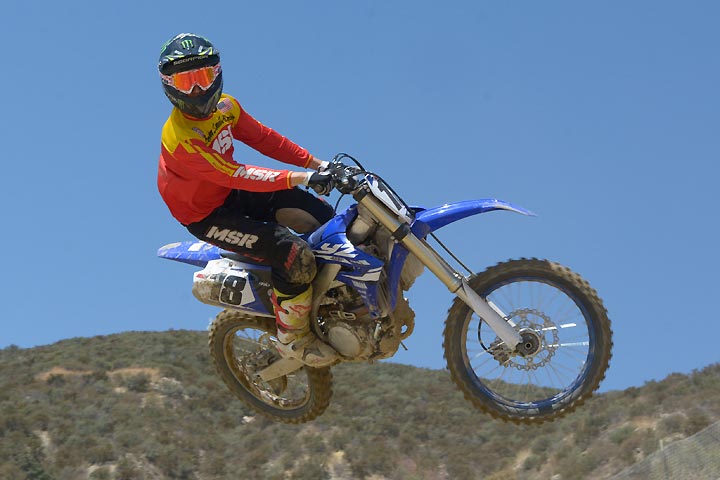
That murderously hot day finally took place at the world famous Glen Helen Raceway in Southern California, yesterday.
Needing a test rider who was up to the task of man-handling the 2018 Yamaha YZ450F at Glen Helen, we invited So Cal-based pro motocrosser and Baja veteran Nic Garvin to swing a leg over the 2018 YZ450F and give us his impressions. Garvin spent a lot of time racing our 2017 Yamaha YZ450F test mule in local motocross and GP events over the past several months, and he also participated in our 2017 450cc Motocross Shootout, giving him a good frame of reference while sampling the 2018 model. Here’s what we found out about the new Yamaha.
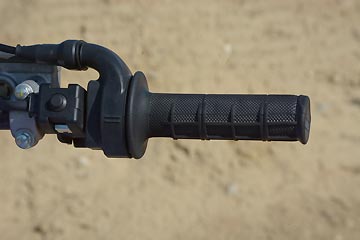 In the swirling sea of changes and updates made to the 2018 Yamaha YZ450F, two stand out. The first is that the bike now features electric start as a standard item—like KTM, Husqvarna and now Honda, the YZ does away with the kickstarter altogether. However, if you read our introduction of the 2018 YZ450F, you already know that its electric starting system is completely different than the one used on Yamaha’s successful WR and FX off-road models. A tiny, 1.5-lb., 2.4Ah/13.2-volt Lithium-ion battery powers the starter, which is mounted behind a reverse-inclined cylinder that is positioned to 2 degrees more upright in the chassis than previous YZ450Fs. The second is Yamaha’s industry-first wireless tuning app for dirtbikes, the Yamaha Power Tuner iOS and Android App, which we’ll talk about later.
In the swirling sea of changes and updates made to the 2018 Yamaha YZ450F, two stand out. The first is that the bike now features electric start as a standard item—like KTM, Husqvarna and now Honda, the YZ does away with the kickstarter altogether. However, if you read our introduction of the 2018 YZ450F, you already know that its electric starting system is completely different than the one used on Yamaha’s successful WR and FX off-road models. A tiny, 1.5-lb., 2.4Ah/13.2-volt Lithium-ion battery powers the starter, which is mounted behind a reverse-inclined cylinder that is positioned to 2 degrees more upright in the chassis than previous YZ450Fs. The second is Yamaha’s industry-first wireless tuning app for dirtbikes, the Yamaha Power Tuner iOS and Android App, which we’ll talk about later.
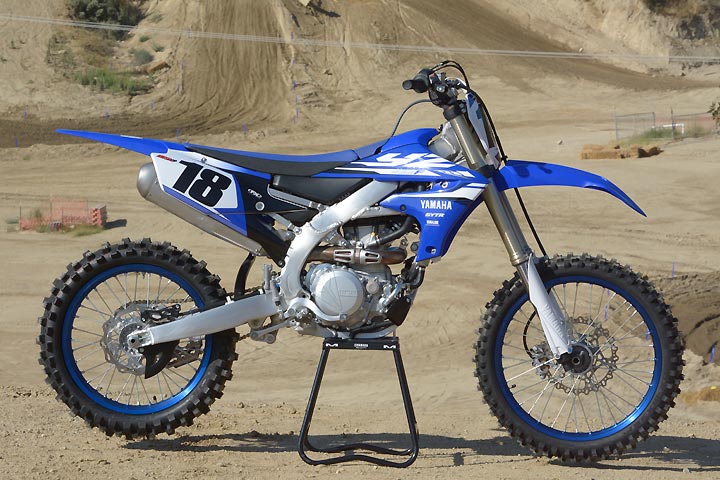
The YZ450F has never been one of the hardest-starting bikes in the class, but we sure as hell don’t miss the kickstarter anyway. Just the push of a handlebar-mounted button is all it takes to bring the new YZ to life. If anything, it starts even more readily than some of the bikes that beat it to the punch with electric start. Warm-up time through the YZ’s all-new Mikuni 44mm throttle body is also minimal. The new throttle body’s cold-start button also has a nifty feature in that it only needs to be pushed in by hand but not pulled back out in by hand. Activating the cold start opens the throttle to a detented position, and canceling the cold start is a simple matter of blipping the throttle.
Once out on the deep, wet Glen Helen track, the first thing that Garvin noticed is that while the 2018 Yamaha YZ450F still feels as if it is one of the most powerful in the class, it doesn’t hit as hard off the bottom as the 2017 model did—exactly what Yamaha engineers were after when redesigning the YZ’s reverse-incline engine, which features a lot of new tricks, such as an F1-style bridged box piston that shaves 6 grams of reciprocating weight and also contributes to a compression ratio increase to 12.8:1, up from 12.5:1. Helping to ensure a more complete burn of the fuel charge is a new spark plug with a longer electrode. A new ignition cool and an ECU with revised settings also help shape the power the way Yamaha engineers intended—to be more controllable down low and stronger on top. You can read about all that and more in our 2018 Yamaha YZ450F reveal feature.
Throttle response is still as crisp as before, and the YZ’s low-end power is stout, but it’s definitely more tractable. The bottom-to-mid-range transition is also much smoother than before, and top-end overrev is stronger than the 2017, something that was readily apparent on the horsepower-sapping Glen Helen track.
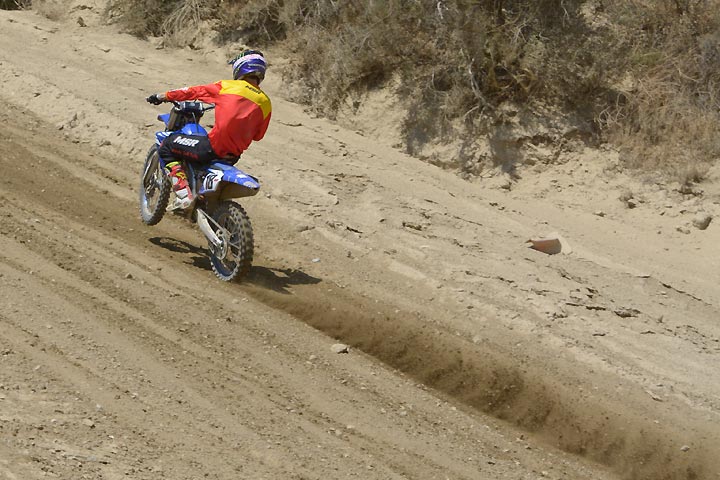
“It feels as if they shifted the power up higher in the rev range,” Garvin said. “It doesn’t come off the bottom as hard, but it will still wheelie in taller gears.”
That would make sense as Yamaha fitted the 2018 Yamaha YZ450F’s fuel-injected, DOHC engine with new intake and exhaust cams that feature higher lift profiles, which lift the intake valves .5mm and the exhaust valves .4mm farther of their seats to draw in more air. Both also feature more duration, and there is also more valve overlap (the amount of time that both intake and the exhaust valves remain open simultaneously). The increased overlap also favors high-rpm power as the exiting exhaust gases effectively help to draw-in the incoming fuel charge.
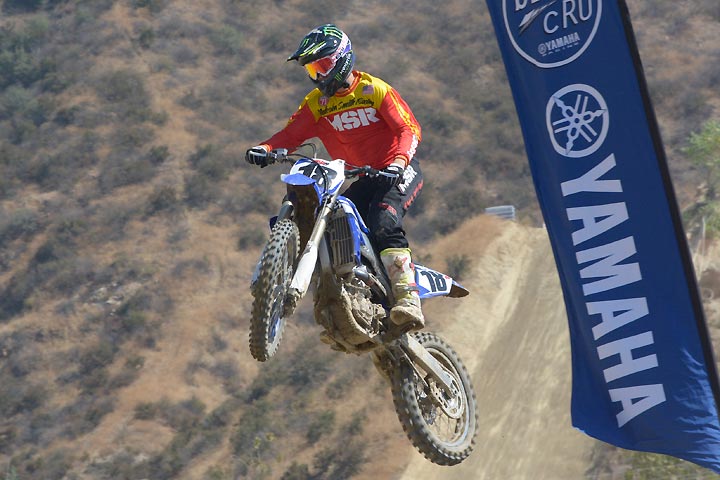
“It feels like it hooks up better than the 2017, and you can carry the same gear for a long way, but I think that Expert riders might still miss the snappy hit of the ’17,” Garvin said.
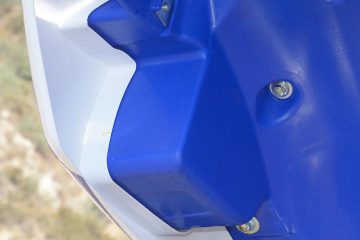
Using settings created by Yamaha test rider Travis Preston and Yamaha engineer Steven Vincent, we fattened up the fuel-injection and recalibrated the ignition curve. The operation was a simple matter of swapping one set of values for the other in a matter of seconds. Once back on the track, Garvin was visibly faster out of Glen Helen’s sandy corners, and the 2018 Yamaha YZ450F roosted up the track’s steep hills and rocketed down its long straightaways.
“It’s sooo much better when it’s remapped,” Garvin enthused. “It feels like the ’17 now, only with more power on top. The YZ450F is an extremely fast motocross bike.”
That would seem accurate, as Yamaha told us that the 2018 YZ450F makes three more horsepower at 6000 rpm and three more horsepower at 9000 rpm than the 2017 did. The 2018 is clearly a thundering 450cc machine, and we have no doubt that it will once again be in the hunt for top honors in the motor department.
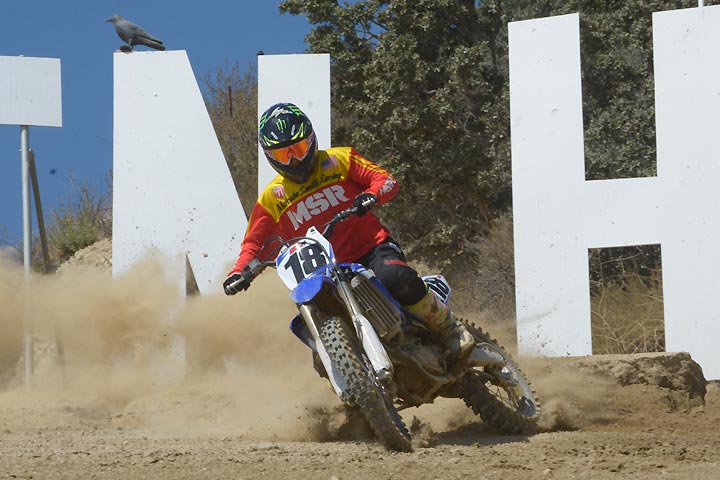
A number of changes to the clutch and transmission were also made for the 2018 Yamaha YZ450F. The clutch is still cable-operated, but Yamaha worked hard to increase the clutch feel by revamping the pressure plate so that its rib shape and thickness is changed. The new pressure plate features slightly decreased center rigidity and slightly increased outer surface rigidity. To enhance the clutch’s silky feel, the YZ’s steel clutch plates are also surface ground on both sides rather than on just one side as they were on past models. New clutch springs also boast straighter alignment when the clutch lever is pulled. The 2018 YZ450F’s five-speed transmission has also been beefed up, with 1mm wider second, third and fourth gears. The shift lever and shift selector drum have also been updated to give a more direct feel at the lever when changing gears.
Garvin noticed that the clutch action is definitely smoother and lighter, but shifting on the 2018 isn’t as precise as the 2017 model.
“I missed a few shifts out there,” he said. “It was kind of weird because it feels really good when you make the shift, but after I missed a couple, I had to concentrate on it more.”
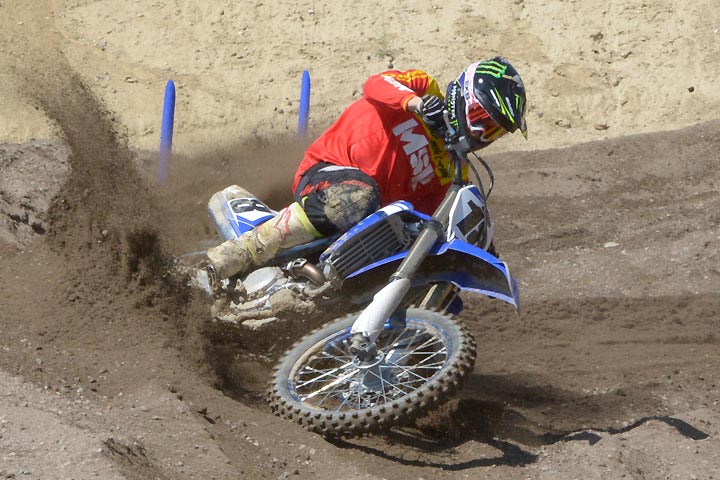
One other surprise to us was that, for a company that seemed to leave few stones unturned to make a statement with its all-new 450cc machine, Yamaha sure left a lot of the character of the 2017 YZ450F’s bilateral beam aluminum chassis in the 2018 YZ450F. Visually, there’s no mistaking one for the other, as the new chassis features much straighter and flatter spars in the air box area, and the rails are extruded rather than hydro-formed. Its tension pipes—the cross brace pieces that form the triangle above the engine—are much longer than on the 2017 model. Yamaha did this to tune the 2018 chassis for more balanced flex than the 2017, which is intended to make it more compliant on rough tracks. The chassis is also narrower to help eliminate some of the bulky feel that some our test rider’s complained about during the 2017 450cc motocross shootout. To improve the 2018’s steering, the steering pipe has been moved 6mm forward while the triple clamp offset was increased from 22mm to 25mm and trail was increased 3mm to 121mm.
On the track, however, Garvin reported that the 2018 YZ450F still handles a lot like the 2017 model did. The YZ is stable, but the front end tends to meander a bit at high speeds, and while turn-in has improved, it’s still not all that easy to get the new chassis to follow a rut. The more flexible feel is also noticeable although not necessarily all that welcome.
“There’s this weird feeling you get where the front end feels like it is moving around a little bit even though the bike is going arrow straight,” Garvin said. “Also, there’s still a bit of a front-end push when going into a rut. I expected the steering effort of the new chassis to be lighter-feeling than the old one, but it really isn’t. I could feel the chassis flex. If I could have my way, I think I’d rather have the more rigid feel of the old chassis along with the slim ergos of the new one.”
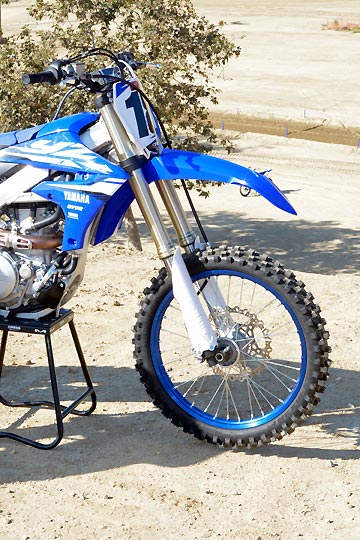
“So, it might sound backwards, but we actually went stiffer on the fork,” Garvin said. “We added two clicks of compression to the front and slowed the rebound down two clicks so that the fork would ride a little higher in the stroke. That made the bike handle better in the rough stuff for sure, because the front end felt more settled. The section right before the hip jump was really rough, and once I made the changes to the fork I was able to attack that section at a much higher speed. So, at the end of the day, all we really did was make changes to get the fork and the chassis feeling a lot like the ’17 model.”
As for the rear, Garvin had no complaints about the 2018 YZ450F’s KYB piggyback shock and rising-rate linkage rear suspension, which handily soak up stutter bumps, braking bumps and Glen Helen’s classic square edges with equal efficiency. Of course, so did last year’s model, but Yamaha nevertheless made changes to meet the needs of the 2018’s new chassis and enhance suspension feel. The shock body sub-tank capacity has been increased 30cc, and the oil flow has been increased in an effort to offer more even and controlled damping. The shock spring is made of thinner material, which also helps reduce the spring weight by 4.8 percent, to 210 grams. The spring rate is also stiffer than the 2017, 58 Newton/mm compared to 56 Newton/mm.
“I like the way that the YZ’s rear end tracks,” he said. “It just follows the front end on the straightaways. You can just put it wherever you want.”
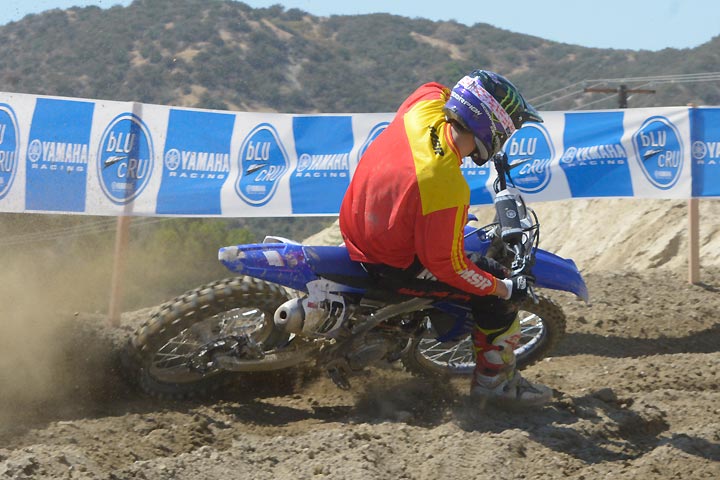
One of our biggest gripes about the 2017 Yamaha YZ450F had to do with its ergonomics, which were influenced by its wide-feeling chassis. With the 2018 Yamaha YZ450F, Yamaha really tried to address the cockpit via a number of changes. Of course, since the chassis is narrower through the middle—10mm at the spars and 6mm down by the swingarm pivot—Yamaha also designed all-new bodywork to capitalize on it and give the rider more room to move. The theme is carried out a few ways, including slimmer radiators that allow the shrouds to be tucked in closer to the frame, a narrower seat and a flatter slope from the front of the seat to the rear fender. Garvin said the changes are definitely noticeable.
“The only complaint about the ergos I have is that the stock handlebar rise is too high for my tastes,” Garvin said. “Other than that, the 2018 Yamaha YZ450F feels nowhere near as fat through the middle as the 2017. I was able to move around on it easily, and that helped to get my body position where it needed to be for cornering and for turning the bike in the air over jumps when I needed to. The YZ still doesn’t feel like the smallest bike in the class, but the riding position helps it to feel pretty light anyway.”
Maybe the biggest gripe that Garvin had all day concerned the 2018 Yamaha YZ450F brakes. The front features a monstrous 270mm front rotor clamped by a Nissin two-piston caliper, while the rear is a 245mm rotor and single-piston caliper. After listening to Garvin, we wondered if Yamaha engineers focused so much on making the YZ’s engine a powerhouse that they forgot there might be a need to haul it down from speed.
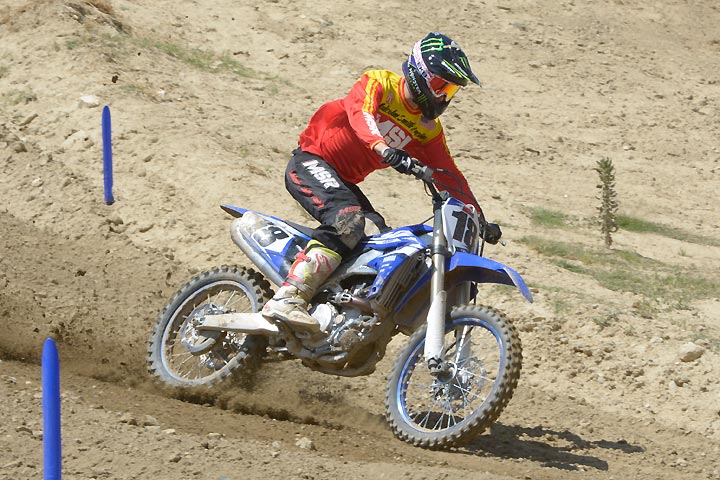
“Honestly, I don’t get it,” Garvin said. “You make a bike this fast and don’t give it braking performance to match? The Yamaha doesn’t have the best brakes in the class by a long ways. The front brake feels mushy to me, and it just lacks the kind of stopping power you’d expect from a bike with a 270mm front rotor. I’d go looking for new pads or a new master cylinder if I owned one. The rear brake feels a little better and seems to work well, but most guys really depend on their front brake to stop fast. I couldn’t stop fast on the YZ.”
At the end of the day, our first impression is that the 2018 Yamaha YZ450F represents an improvement over the 2017 model, though it’s not a night-and-day difference. The ‘18’s motor is more flexible than the ‘17’s, and its power curve can be easily tuned to make it feel faster than the ’17. Its electric start, Wi-Fi tuning capability and slimmer ergos are all real positives as well. We’re just not sure that the 2018’s chassis is better than the 2017’s despite the major redesign. At $9199, the 2018 costs $500 more than the 2017. The electric start and Wi-Fi tuning features alone are justification enough for that.
“Overall, their target is to make a speedy 450cc motocrosser, and they put a lot of effort into the 2018 Yamaha YZ450F,” Garvin said. “It makes great power, and I love the electric start. The Yamaha Power Tuner App is rad—that is really cool thinking outside the box. But it seems to me that for all the redesigning that Yamaha did, the overall package doesn’t perform a whole lot better than the 2017. It has some cool features, and it feels different, but I could be just as happy on last year’s bike, and I really liked last year’s bike. I guess it just isn’t the quantum leap we expected.”
2018 Yamaha YZ450F Specifications
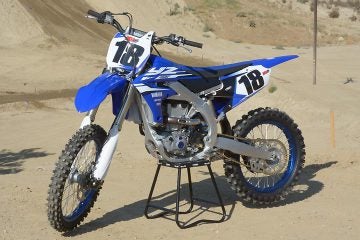 Engine: 449cc liquid-cooled DOHC 4-stroke; 4 titanium valves
Engine: 449cc liquid-cooled DOHC 4-stroke; 4 titanium valves
Bore x Stroke: 97.0mm × 60.8mm
Compression Ratio: 12.8:1
Fuel Delivery: Mikuni fuel injection, 44mm
Ignition TCI: Transistor Controlled Ignition
Transmission: Constant-mesh 5-speed; multiplate wet clutch
Final Drive: Chain
Front Suspension: KYB Speed-Sensitive System inverted fork;
fully adjustable, 12.2-in travel
2018 Yamaha YZ450FRear Suspension: KYB single shock; fully adjustable, 12.5-in
travel
Front Brake: 270mm disc w/two-piston caliper
Rear Brake: 245mm disc w/two-piston caliper
Front Tire: 80/100-21 Dunlop MX3S
Rear Tire: 120/80-19 Dunlop MX3S
Length: 86.0 in.
Width: 32.5 in.
Height: 50.6 in.
Seat Height: 38.6 in.
Wheelbase: 58.5 in.
Rake: (Caster Angle) 27.33°
Trail: 4.7 in.
Ground Clearance: 13.0 in.
Fuel Capacity: 1.6 gal.
Claimed Wet Weight: 245 lbs.
Warranty: 30 Day (Limited Factory Warranty)
MSRP: $9199
Color: Factory Yamaha blue, white
 Your Privacy Choices
Your Privacy Choices